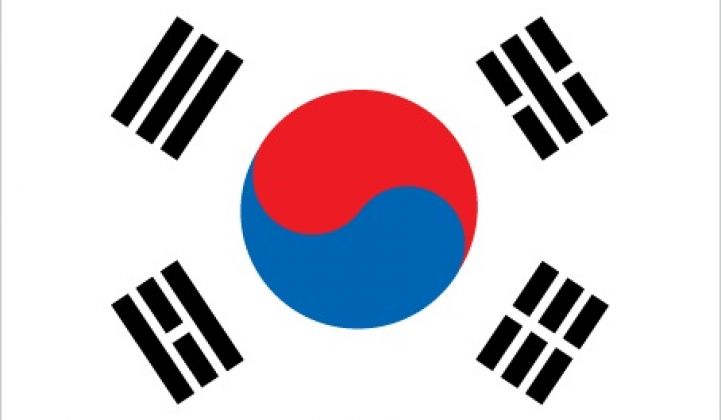Last week we reported that Samsung was withdrawing from the crystalline solar market, a market to which it had previously pledged billions of dollars of investment.
This week we've learned that Hyundai Heavy Industries, another Korean giant with photovoltaic aspirations, is calling it quits, according to an article in the Korea Times.
And we've heard rumors that Korea's LG is also restructuring its solar business.
Greentech Media has long viewed Samsung and the Korean industrial machine as a force to be reckoned with in greentech and solar.
But the downturn in the solar market might be proving too much for even the Korean giants to bear. At least in crystalline silicon.
The report in the Korea Times quoted an unnamed Samsung official as saying, "The solar-cell market is reeling from continued oversupply amid aggressive expansion by Chinese cell manufacturers." The official continued, "We are evaluating the business on a 'zero-base.'"
Hyundai is "scrapping plans to build two solar photovoltaic power plants roughly valued at $700 million in Arizona," according to company officials. "The market demand is way below expectations. The feasibility is lost," according to a source quoted in the article. Hyundai had about 500 megawatts of production capacity in Korea.
Hyundai is looking to sell off its hundreds of millions of dollars of crystalline silicon production equipment from factories which had very low utilization rates.
Greentech Media spoke with Samsung executives last year and they expressed an interest in dominating solar everywhere from silicon to thin film to inverters. Last year, Samsung said it would invest approximately $20.6 billion and boost employment by around 45,000 as part of its expansion into solar, energy efficiency, light-emitting diodes and other green markets. Samsung had said it wanted to be number one in solar by 2015. Samsung also said it would invest around $6.6 billion into solar and wind projects into Ontario.
Depending on one's viewpoint, Korea exiting the crystalline silicon business could be a sign of timidity or genius.
Despite the withdrawal from crystalline silicon (c-Si), Korean industrial giants continue to invest in thin-film solar with the hope of beating c-Si on price or performance.
HelioVolt received a white-knight investment from Korea's SK Innovation for its CIGS technology in September of last year. Stion, also a CIGS vendor, received a major investment from Korean equity firms as it established a Korean subsidiary. Thin film firms like NanoSolar or MiaSolé or CPV firms like Energy Innovations would welcome investment from Korean sources.
A senior staffer at a top solar manufacturer commented that this was inevitable -- latecomers to the market expecting a high margin business were going to be confronted by compressing margins in an increasingly competitive business. This was the mark of consolidation in the market.
The bottom line is some pain for Korea and Korean workers, but the beginning of a global market rationalization with consolidation and a reduction in c-Si cell and module oversupply. The market will emerge healthier for it.



